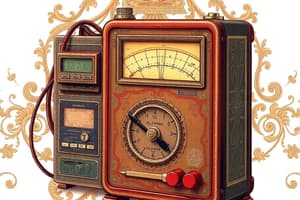Podcast
Questions and Answers
Which of the following is an advantage of using an analog multimeter?
Which of the following is an advantage of using an analog multimeter?
- It has a standard scale that eliminates confusion.
- It can make multiple measurements using different devices.
- It provides continuous readings for sudden signal changes. (correct)
- It is highly accurate compared to digital multimeters.
What is a noted disadvantage of analog multimeters?
What is a noted disadvantage of analog multimeters?
- They are lightweight and compact.
- They offer multiple measurements in one device.
- They can be confusing due to multiple scales. (correct)
- They are more accurate than digital multimeters.
Which function does not typically belong to a digital multimeter?
Which function does not typically belong to a digital multimeter?
- Resistance measurement
- Current measurement
- Voltage measurement
- Statistical analysis of data (correct)
What is the primary function of a cathode ray oscilloscope (CRO)?
What is the primary function of a cathode ray oscilloscope (CRO)?
What is a characteristic of a digital volt meter (DVM)?
What is a characteristic of a digital volt meter (DVM)?
Which of the following is an advantage of using an analog multimeter?
Which of the following is an advantage of using an analog multimeter?
Which of the following is a disadvantage of using an analog multimeter?
Which of the following is a disadvantage of using an analog multimeter?
What primary function does a digital multimeter offer that is not inherent to analog multimeters?
What primary function does a digital multimeter offer that is not inherent to analog multimeters?
Which characteristic is true regarding a Cathode Ray Oscilloscope (CRO)?
Which characteristic is true regarding a Cathode Ray Oscilloscope (CRO)?
Which of the following characteristics is typically associated with digital volt meters?
Which of the following characteristics is typically associated with digital volt meters?
Flashcards are hidden until you start studying
Study Notes
Analog Multimeter
- Analog multimeters provide continuous readings, allowing detection of sudden signal changes.
- They are affordable and can perform all measurements with a single meter.
- Analog multimeters are bulky and have multiple scales, which can lead to confusion.
- They have low input resistance and are less accurate than digital multimeters.
Digital Multimeter
- Digital multimeters measure various electrical quantities, including voltage, current, resistance, temperature, frequency, capacitance, continuity, and transistor gains.
- They use a function switch to select different measurement modes, like AC or DC voltage, current, or resistance.
- A D.C. voltage divider, consisting of a chain of resistors, measures DC voltages within different ranges.
- A rectifier converts AC voltage to DC voltage proportional to the RMS value, using the same resistance chain for both AC and DC voltage measurements.
- Current sensing resistors measure current by measuring the voltage drop across them, which is proportional to the current being measured.
Digital Voltmeter (DVM)
- Digital voltmeters measure DC voltage with a basic range of 2V. They are often incorporated as chips within DMMs.
Digital Multimeter Display
- Digital multimeters use either LCD or LED displays to show measurement results.
Cathode Ray Oscilloscope (CRO)
- CROs are electronic instruments that transform electrical signals into visual signals for analysis.
- They incorporate a Backlighting Unit (BLU) that uses fluorescent lamps to illuminate the LCD panel.
- The Housing Panel houses the LCD panel and BLU panel in parallel, containing the CCFL rows.
- CROs also include reflectors, brightness controllers, and diffusers.
Liquid Crystal Display (LCD)
- LCDs are lightweight and compact compared to CRT displays.
- LCDs generate heat during operation and rely on a BLU for functionality.
- The viewing angle of LCDs is limited.
LCD Applications
- Televisions
- Computer monitors
- Digital cameras and projectors
- Digital display devices
Analog and Digital Displays
- Analog displays use a moving pointer to indicate measurements on a graduated scale.
- Digital displays do not have moving parts and display measurements numerically.
Digital Display Types
- Light-Emitting Diode (LED) displays utilize LEDs that emit light when forward biased, with color determined by the material used.
- Liquid Crystal Display (LCD) displays also rely on LEDs but differ from LED displays in their BLU technology.
Studying That Suits You
Use AI to generate personalized quizzes and flashcards to suit your learning preferences.




